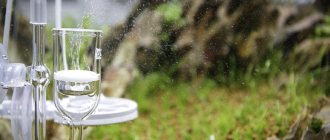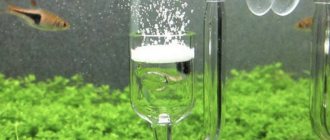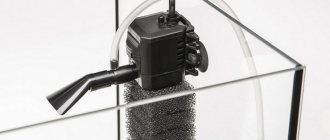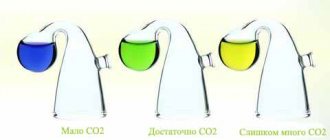Carbon dioxide dissolved in water is one of the unshakable pillars on which the biological balance of the aquatic environment in an artificial reservoir is maintained. It is necessary for the normal growth and development of underwater flora, and its natural sources of formation are the decomposition of waste from the inhabitants of the reservoir. But despite this, many reservoirs contain insufficient amounts of co2 mash for an aquarium, so every owner of a fish tank should know how to supply carbon dioxide and the mash recipe.
A little theory
Using carbon dioxide, you can adjust the pH of aquarium water and select it according to the requirements of specific plant species. Most aquarium inhabitants prefer an acidic pH.
When creating a CO2 supply system for an aquarium, be sure to provide sufficient lighting, aeration and filtration. Without these conditions, carbon dioxide can harm fish, causing acidosis or death from cardiac arrest.
Suppliers of equipment for aquarists offer ready-made sources of carbon dioxide:
- lime tablets that dissolve to produce co2;
- devices that produce carbon dioxide by electrolysis from coal blocks;
- carbon dioxide supply cylinders equipped with a solenoid valve and pH controller.
Like all people who are passionate about their hobby, aquarists, understanding the intricacies of the functioning of an enclosed miniature reservoir, develop their own methods of supporting the life of their pets. An alternative source of co2 is easily made with your own hands. To do this, you need to get acquainted with the alcoholic fermentation of yeast. Simply put, learn how to make mash.
It would seem, what could be simpler? Dilute sugar in water, add yeast, wait until the yeast begins to feed and releases alcohol and co2. However, when choosing a mash recipe, the paths of the moonshiner and the aquarist diverge. To produce moonshine, mash is expected to have a fast fermentation rate and a high percentage of alcohol content. The mash recipe for delivering co2 to the aquarium should have the opposite characteristics. Its most valuable quality will be the longest possible duration of carbon dioxide release. This means that the wort must contain components that inhibit and slow down fermentation. An aquarist's mash recipe should not produce a high-strength product. At 10-11? the yeast dies, therefore the formation of co2 stops.
Methods for saturating the aquatic environment with carbon dioxide
Carbon dioxide diluted in the aquatic environment is necessary for the formation of aquarium flora, and its amount must be at least 15 mg/1 liter of water. Carbon dioxide helps plants carry out photosynthesis and also helps reduce acidity levels in water. Unfortunately, despite the natural sources of CO2 creation - fish respiration and waste decomposition, the level of carbon dioxide in many tanks is insufficient to maintain biological balance in the aquarium and plant growth. Therefore, systems and devices have been created to artificially saturate the liquid in the tank with carbon dioxide.
Before talking about these methods, you should make sure that when artificially saturating a reservoir with co2, you need to provide the aquarium with:
Without these three steps, the supply of carbon dioxide will harm the inhabitants of the aquarium, causing the development of disease or death, as well as clouding of the water and the rapid growth of harmful algae.
Aquarium water is saturated with carbon dioxide using one of the following methods:
Most aquarists prefer the latter option, since the construction of such a system is easy and convenient to use. To fill water with carbon dioxide, you only need ingredients for mash and a few items that can easily be found in any home.
The fermentation system, like any of the above options, has a couple of disadvantages:
Braga suitable for aquariums
Changing the ratio of water, sugar, yeast, experimenting with temperature conditions, adding various components, adding layered structure to the wort? experiments to develop technology
preparing ?slow mash? for the aquarium do not stop. Below are a few proven recipes.
Recipe with added soda
?Long-lasting? The brew according to this recipe ferments and releases co2 for a long time due to the presence of baking soda in the recipe. Sodium bicarbonate or ordinary soda creates an alkaline reaction in the sugar wort. In such an environment, fermentation slows down.
Pour 200-250 grams into a 1.5 or 2 liter bottle. sugar, 1 tsp. soda, ? tsp dry yeast Saf-Moment. Add warm water (about t=30°C), not filling to the top 5-7 cm. The liquid does not need to be stirred, gradual processing of sugar will extend the period of co2 generation to 1 month.
Gelatin recipe
A special feature of this recipe is the layering of the wort. Sugar, mixed in a gelatin solution, is located at the bottom of the bottle, and yeast, diluted in a small volume of water? at the top. As a result, they do not have access to the entire volume of sugar at once, but process it gradually, only in the contact zone. The release of CO2 is quiet and continuous. If you change the upper part of the liquid from time to time, adding water with fresh yeast, you can extend the life of such a brew to several months. For 1 liter of water: 1 tbsp. l. gelatin, 1 tbsp. l. soda, 3 tbsp. sugar, 1 tsp. dry active yeast (such as Saf-Moment, Pakmaya, etc.). Pour gelatin into a glass of cold water and leave to swell for an hour. Heat with the rest of the water, sugar and soda while stirring constantly. Do not bring to a boil, but the grains of gelatin and sugar should completely dissolve. Cool the liquid to t=30°C, pour into a 2-liter plastic bottle. Allow the yeast to dissolve in a glass of water at the same temperature and carefully pour it onto the surface of the wort.
Starch recipe
Braga with the addition of starch is an excellent supplier of co2 to the aquarium. The benefit of this recipe is:
that in the nutrition of yeast and the production of co2, part of the sugar replaces saccharified starch.
Pour 1 liter of water into a 2-liter bottle made of durable plastic, add 10 tbsp. l. sugar, 4 tbsp. l. starch, 2 tbsp. soda Heat in a water bath, avoiding boiling, until jelly forms. The volume of wort will increase during cooking. Cool to t=30°C, just like in a gelatin mash, pour a glass of water with 1 tsp on top. yeast.
Operating principle
In natural habitats (rivers, lakes) there is plenty of carbon dioxide contained in the water for aquatic vegetation, which is why they grow intensively and develop. Fresh water contains approximately 15 mg/l CO2.
The gas arises from the respiration of the inhabitants of the water surface, the “processing” of organic matter at the bottom by bacteria, etc. But in aquarium conditions it is impossible to ensure the natural production of carbon dioxide. Therefore, it is necessary to saturate the water artificially.
There are several ways to supply CO for aquariums:
- Special cans of carbon dioxide and devices that control its level. But such installations have a significant drawback - a high price, equal to approximately 200 US dollars. To put it simply, only people who are not limited in funds can afford such a luxury.
- Tablets that, after being thrown into water, stimulate the production of carbon dioxide. For $9 you can buy a dozen, and then buy more over and over again. Not the best option either.
- Homemade mash, supplied to the aquarium using a homemade device. Moreover, the “generator” of carbon dioxide, mash, can work for up to 3 months if prepared correctly! And the cost of such a “device” tends to zero. Although, of course, the components for the mash cost something, and for installation you will have to buy some cheap parts.
Design of a simple co2 generator for an aquarium
It is easy to make a carbon dioxide supply system with your own hands from available materials. The basis of the design is a durable plastic bottle of suitable volume with a stopper and flexible tubes of suitable length. The tubes can be silicone or PVC (for example, from medical IVs).
A hole is made in the plug corresponding to the diameter of the tube and it is inserted. Any construction or automotive silicone sealant is suitable for sealing the connection. Now, if you fill the bottle with mash, carbon dioxide will escape through the tube. Large co2 bubbles will not bring any benefit to aquarium inhabitants. They will simply rise to the surface and go into the atmosphere. For carbon dioxide to work, it must be dissolved in water. This can be achieved in several ways:
- Connect the outlet tube to the aquarium filter.
- Use a pump for these purposes.
- Just attach the sprayer to the end of the hose.
- The smallest bubbles are obtained by inserting a piece of rowan branch into the end of the tube. In order for CO2 to pass unhindered, the length of the rowan segment should not exceed 1.5 cm.
- Instead of a sprayer, you can supply carbon dioxide under the bell. It consists of a small container (cup, deodorant cap) turned upside down and fixed at the bottom. Co2 collects under the bell and gradually dissolves. Diffusion works better in soft water.
To be able to regulate the gas supply process, a check valve is added to the design to shut off the tap. The circuit includes an additional intermediate
a container, similar to a steamer in moonshine brewing, to prevent mash from getting into the aquarium.
Some tips for making mash
- Additional yeast feeding will help ensure complete fermentation in a homemade co2 generator. For this, ammonium salts (nitrogen mineral fertilizers), complex compositions of microelements and vitamins, brewer's yeast extracts, and black bread are used.
- It is better to pack a bottle of mash in a cardboard container. It will protect the yeast from direct light, which negatively affects its activity.
- To maintain a constant temperature, the fermentation tank can be wrapped with some kind of insulation: padding polyester, foam rubber, building insulation.
- You should select the right plastic containers for co2 production. Bottles for highly carbonated drinks have a sufficient safety margin and are designed for high pressure.
- Fermentation containers are filled no more than 2/3 with wort and placed strictly vertically, otherwise foam may get into the CO2-conducting tubes and the aquarium.
A properly selected mash recipe and a well-functioning design of gas supply to the aquarium will allow you to generate co2 without recharging for several months. A sign that the system is functioning normally and carbon dioxide is supplied in the required quantity? small oxygen bubbles on the back of the leaves. They should appear with the lighting on in 5-6 hours.
Precautionary measures
The owner of the aquarium must know how to use a homemade reactor so as not to harm the inhabitants of the underwater ecosystem:
- How much carbon dioxide is in aquarium water can be monitored using tests that are sold at the pet store. You can also install a drop checker to determine the degree of water hardness. The principle of operation of the device: the liquid in it turns yellow when there is excess CO2 content, green when it is normal, and blue when there is a deficiency. If there is an excess of carbon dioxide, fish suffocate and die; if there is a deficiency, plants suffer.
- When using a generator, you need to check the pH level of the water, since carbon dioxide lowers the acidity, which can cause discomfort in the fish.
- Photosynthesis does not occur without ultraviolet light, so you need to regulate the intensity and duration of the aquarium lighting.
- For active development, plants need not only carbon dioxide, but also mineral fertilizers.
- If there is excessive production of CO2 (more than 30 mg/l - a toxic dose for fish), the generator is removed and the operation of the aerator is increased. In severe cases, hydrogen peroxide is used.
Some aquarists use store-bought preparations to generate carbon dioxide, or create reactors at home using fire extinguishers and gas cylinders. However, working with pressure vessels is a dangerous undertaking and should not be attempted without experience.
Carbon dioxide is a key element for the full functioning of plants. To make a simple and effective CO2 generator, you need a minimum set of devices and tools, a little time and skill.










